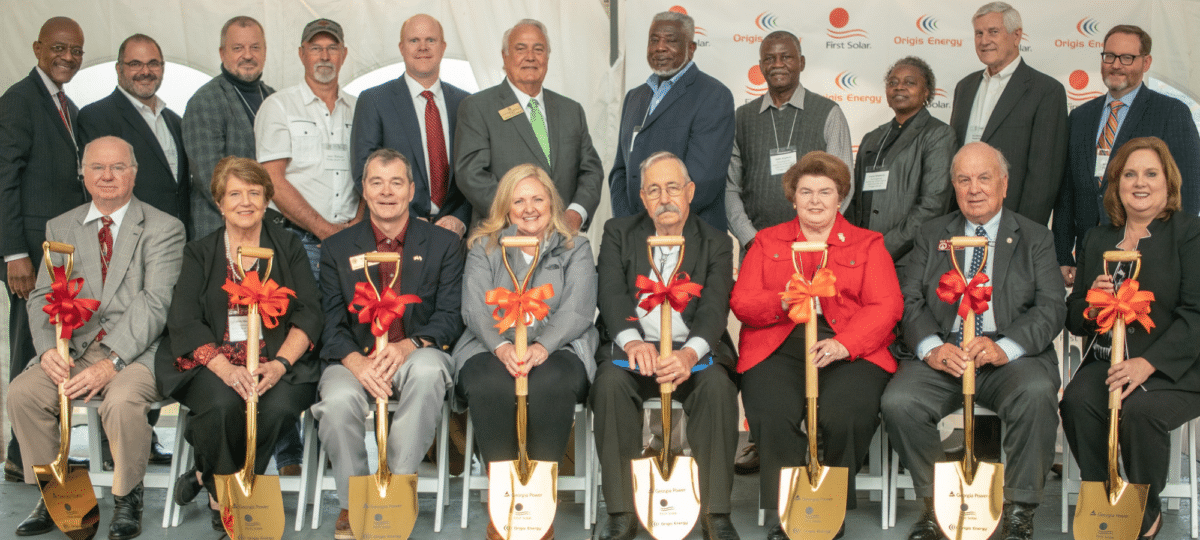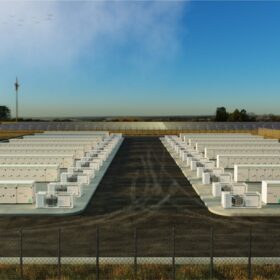Last week was a week of superlatives. The largest battery systems in the world were approved in California, and Entergy (an unlikely actor) signed a contract with Canadian Solar for the largest solar plant in Mississippi. If one more of these stories were to break, we might have to hit the thesaurus.
On Thursday, First Solar and Miami-based developer and independent power producer Origis Energy held a ceremony to celebrate the beginning of construction on the GA Solar 4 Project. Origis bought the project three weeks ago from First Solar, which is the party who will lead construction of the 200 MW-AC project, using over 400,000 of its large-format Series 6 modules.
This makes GA Solar 4 the 2nd-largest solar project East of the Mississippi, second only to the massive 400 MW Piedmont project in Virginia.
As seen in the above photo, everybody was there. And by everybody, I’m including not only county, Origis and First Solar officials, but at least three sitting members of the Georgia Public Service Commission (GPSC). This includes two champions of solar on the GPSC – Chair Lauren “Bubba” McDonald (R) and Vice-Chair Tim Echols (R) – as well as Patricia Pridemore (R), who was appointed by Governor Nathan Deal (R) and who has been a favorite of utility giant Southern Company.
In Georgia conservatives – led by Bubba McDonald and Tea Party leader Debbie Dooley – have been a core element of solar advocacy, and starting as early as 2012 the GPSC pushed Southern Company subsidiary Georgia Power to deploy significant amounts of large-scale solar in its service area.
This was alluded to by First Solar. “This project is a direct result of the Georgia Public Service Commission’s visionary efforts to expand solar in the state,” said Omar Aboudaher, regional director of project development for First Solar. “We are more hopeful today that the GA Solar 4 project is a stepping stone to the greater expansion of solar energy in the state.”
Local economic development is another motivating factor behind the growth of solar in the state, which includes the large city of Atlanta but also significant areas of rural farmland, such as Twiggs County, where GA Solar 4 is located.
“Twiggs County leaders have worked closely with First Solar to make this project a reality,” said Johan Vanhee, managing director, business development and operations for Origis Energy. “It will make a very strong positive difference in the area’s economic growth and long-term tax base.”
As such, the groundbreaking for GA Solar 4 is a view into the new consensus around large-scale solar in Georgia – a consensus which includes regulators, local governments and to a degree Southern Company.
However, the utility-scale solar boom in Georgia has not yet extended to distributed solar, nor has it caused Southern to give up on its nuclear ambitions. Despite scandals resulting from having ratepayers on the hook for the ballooning costs of Vogtle units 3 and 4, Southern Company Chair and CEO Thomas Fanning remains one of the few utility CEOs who remains an outspoken proponent of building new nuclear reactors.
This content is protected by copyright and may not be reused. If you want to cooperate with us and would like to reuse some of our content, please contact: editors@pv-magazine.com.









Hi Christian,
Interesting article on consensus in Georgia over utility-scale solar. I think everyone wants Georgia to take advantage of solar energy, but I don’t understand why I keep reading articles that allude to the failure of distributed solar in Georgia, yet none explain why that is the case. In my comment to Tim Sylvia’s article of July 12th titled “Halfway into the year, Duke hits South Carolina net metering cap”, I spelled out how Southern Company and the PSC doomed the legislation that had been designed to boost distributed solar development in Georgia. It was interesting that you responded to all of the comments for that article (some twice), except for mine. In case you didn’t see it then, you can still my comment online at https://pv-magazine-usa.com/2018/07/12/halfway-into-the-year-duke-hits-south-carolina-net-metering-cap/. If you would like to hear the specifics that led me to the conclusions made I would be happy to share. Regardless, the impact of the policy power companies have been allowed to practice in Georgia on distributed solar producer/customers is significant. In the last year I have paid my electric cooperative over a thousand dollars for power produced by my solar array during the day that I then used overnight. It amounts to me paying them 8 cents per kilowatt hour for that energy, extends my payback period, and keeps me subject to rate increases on approximately 30% of the power I produce and consume.
Hello Mike,
I appreciate your reading pv magazine. My apologies that I didn’t get to your comment on the Georgia article; I don’t respond to all the comments on Tim’s article’s, only some of them. If we haven’t gone into why rooftop solar is failing in Georgia, it is because in the two stories you mention we deal with concrete developments where the failure of DG in Georgia is only a footnote, and something else is the main story.
And if we didn’t specifically cover the policy developments that doomed rooftop in Georgia in its own article, it is likely because we missed significant developments when they happened. We are improving in that regard, but we cover 50 states plus DC and federal action, so try as we may we just don’t catch everything.
We may choose to revisit why and how Georgia (and other Southern states) are choosing large utility-scale solar over DG, and if we do I will reach out to get your perspective. In the interim, thanks for your patience.